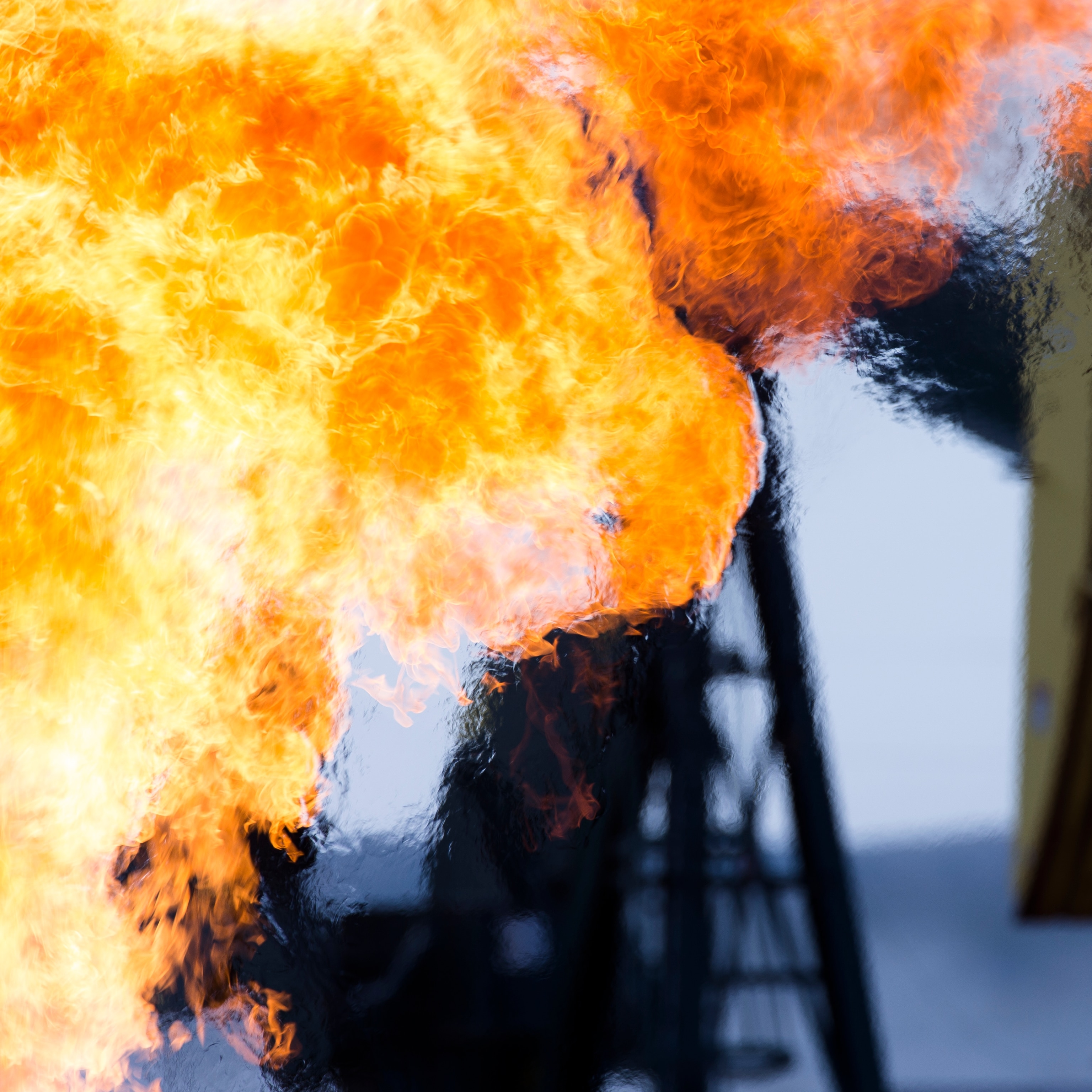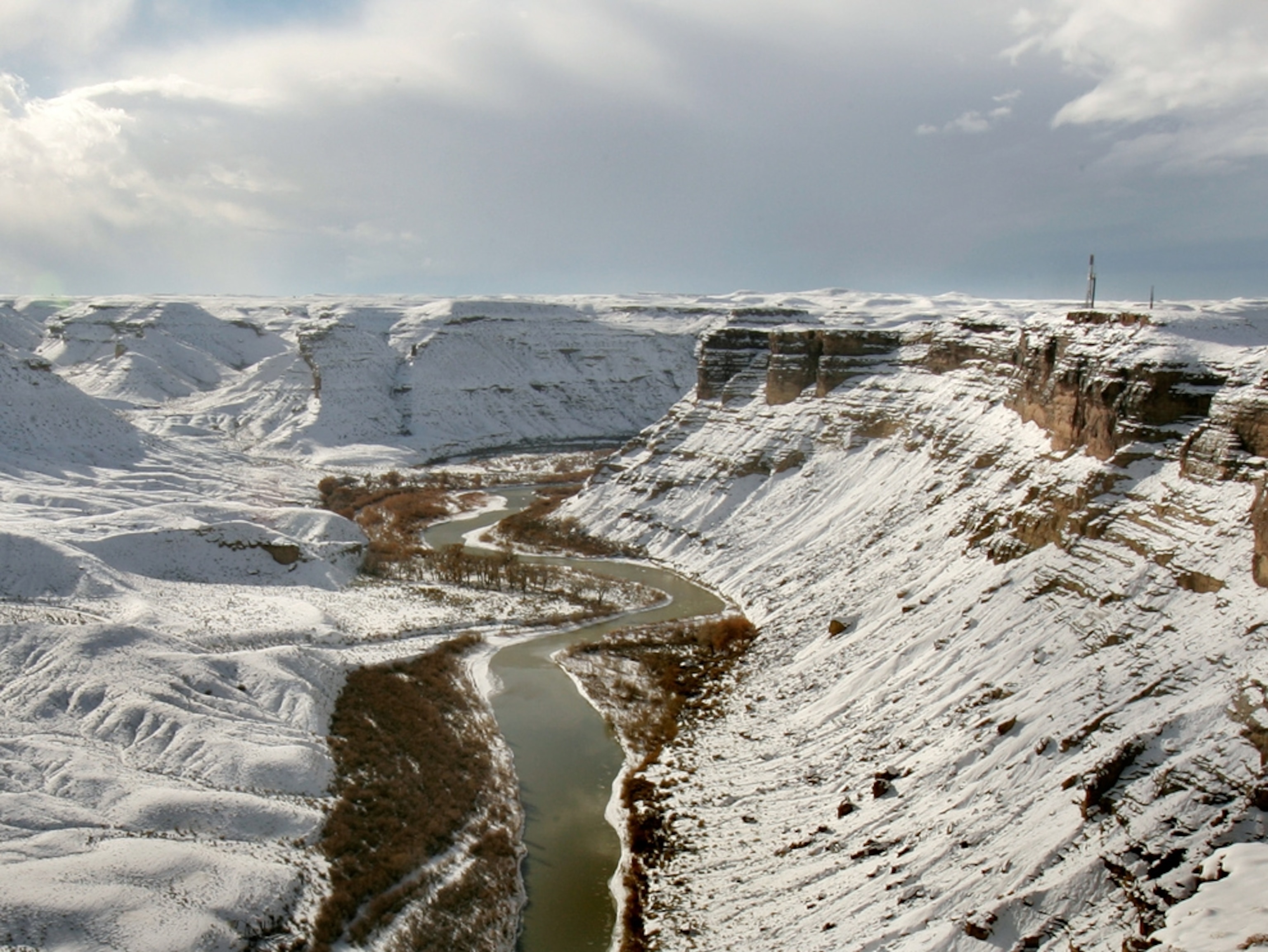
Oil Drillers' Burning of Natural Gas Costs U.S. Millions in Revenue
New report highlights loss to taxpayers from gas wasted on public land.
In oil-rich North Dakota, gas flares dot the landscape like city lights, torching natural gas that the industry won't use. The burning flares are a hallmark of a booming U.S. oil industry in which natural gas, a valuable energy source itself, often becomes a waste byproduct of drilling.
Now, the cost of flaring—in lost energy resources and potential revenue from federal land in North Dakota and other western states—is increasingly drawing the attention of government officials and interest groups.
A new report released by the Western Values Project (WVP), a nonprofit focused on sustainable land development, estimates that the federal royalties lost from U.S. gas flaring amounted to more than $50 million in 2013. That lost gas could have powered all the homes in Chicago for a year, according to the report.
Oil companies burn off natural gas for several reasons: sometimes to prevent a dangerous buildup of methane at a drilling site, but more often because the companies do not have the equipment or the financial incentive to capture and sell it.
"Waste of the magnitude that's occurring through the flaring of natural gas during oil and gas development can't be overlooked," said Ross Lane of the WVP. "Inaction is not an option." (Related: "Space View of Natural Gas Flaring Darkened by Budget Woes.")
Besides examining how much taxpayers could be losing from gas flaring each year, the report highlights how little is known about the extent of the problem. The federal Bureau of Land Management (BLM) held a hearing on the issue last week, and the agency continues to evaluate tighter rules to prevent the waste of gas on leased federal land.
And officials in North Dakota, which until now has been relatively tolerant of flaring, are stepping up efforts to prevent it. Governor Jack Dalrymple, speaking Wednesday at a conference on the oil industry, said his state no would longer grant oil developers permission to flare gas for more than one year.
How Much Gas Goes Up in Flames?
Gas flaring occurs worldwide, and the United States falls far behind Russia and Nigeria in the World Bank's rankings of nations that waste the most natural gas.
But even as the U.S. turns to natural gas to solve more of its energy problems, its volume of flared gas has risen more steeply than elsewhere because of the country's explosive growth in oil and gas production.
Low natural gas prices in the U.S. have given oil companies little incentive to focus on installing infrastructure such as on-site gas-capture equipment, pipelines, and processing plants that would make it possible to sell the gas. From an emissions standpoint, flaring is considered better than venting straight into the atmosphere, so excess gas is burned.
Companies using federal land can get approval from the Bureau of Land Management for various types of gas venting or flaring, and no payments are due on that "authorized" lost gas. But a royalty—at a rate of 12.5 percent of total revenue, the rate for federal onshore leases—must be paid for any flaring that is "unauthorized," or done without permits.
Recent analyses of just how much gas is being wasted nationwide, however, are difficult to come by. (Related: "As Iraq's Oil Boom Progresses, So Does Gas Flaring.")
Data from the U.S. Office of Natural Resources Revenue (ONRR), which tracks and collects royalties due from companies that mine resources on public land, show that the amount of gas lost to unauthorized flaring and venting increased more than 20-fold from 2010 through 2013.

The sharp increase, particularly starting in 2012, comes primarily from New Mexico. The state lacks infrastructure to handle the gas associated with oil development, according to the BLM, and the gas itself is poor quality that cannot go directly into a pipeline.
Companies themselves report the numbers on unauthorized flaring, and ONRR has limited means to verify such reports. The agency has introduced new processes aimed at making sure companies report correctly, ONRR's Patrick Etchart said. Besides using data mining to fact-check reported numbers and placing on-site auditors at larger drilling companies, the ONRR has been issuing more frequent penalties in recent years to companies for reporting violations.
"We really have been strengthening our enforcement efforts to make sure the companies are reporting right and to make sure they get the message on this. And that has been fairly successful," Etchart said.
A "Useless" Analysis?
The amount of gas flared without permits on federal land—about five million mcf (thousand cubic feet) in 2013, or enough to meet the annual needs of about 50,000 American homes—is significant, but just a small fraction of what is presumed to be lost on both public and private lands. (The Energy Information Administration's latest figure, from 2012, puts that total amount at 212.8 million mcf.)
The WVP cited a Government Accountability Office report that used 2006 data to estimate that as much as 5 percent of all natural gas produced on public land was flared or vented. Using that estimate and ONRR data on total gas produced, the report estimated that at least 111.8 million mcf was lost in 2013 on federal lands alone. That amount represents at least $53.4 million in lost royalties, the report said. (See related quiz: "What You Don't Know About Natural Gas.")
But applying a general percentage based on a 2006 analysis to all 2013 production leaves the report open to second-guessing from critics.
"Their analysis is so simplistic that it's pretty much useless," said Kathleen Sgamma, vice president of government and public affairs for the Western Energy Alliance, an industry group. "They're not taking into account many things."
Sgamma pointed out that royalties from produced oil and gas far exceed those from lost gas, and noted that even if that lost gas had been captured, it would not be assured a certain price on the market because supply is so abundant and prices are low.
"Assuming you're going to get the full price [for captured] natural gas ... is not a good assumption," Sgamma said. "It doesn't take into account all the infrastructure [and transportation] costs of that natural gas."
Ross Lane of WVP acknowledged that government analysis of the problem needs updating, but affirmed the report's conclusions. "We feel it's likely that venting and flaring rates have increased since the original [GAO estimates] were released," he said. "The declining price of natural gas, coupled with an increase in oil production on public lands, makes the case that without the financial incentive to capture the gas, it's both cheaper and easier for industry to flare it."
Fixing the Flaring
Wrangling over hard numbers aside, there is no disagreement that waste is occurring.
"This is a resource that has economic value. You're not going to purposefully burn a potential revenue stream," said Jack Ekstrom, vice president of corporate relations for Whiting Petroleum, which operates drilling operations in North Dakota, Colorado, and elsewhere across the U.S. "You just don't do that unless you have no other option."
In North Dakota, which typically has been flaring about one-third of its gas, the oil boom has occurred in the absence of gas processing plants and pipelines to carry product away from the drilling sites. Sgamma said "there was definitely a lag" between when the first oil wells were drilled in North Dakota and when capital from oil production was directed toward infrastructure for capturing gas. (Related: "Energy to Burn: Making Choices by the Light of a Gas Flare.")
Whiting Petroleum recently built two gas processing plants in North Dakota and just completed a third in Colorado. Ekstrom said that Whiting's size made it possible to invest in such facilities, which he said tend to have an upfront cost of about $60 million. Whiting now processes gas from its operations, and from smaller operators that can't afford to build their own processing facilities.
The oil company Hess also just completed upgrades to its gas plant in the northwestern part of North Dakota. The new infrastructure means that gas flaring percentages there are expected to go down, according to Alison Ritter of the North Dakota Department of Mineral Resources. (See pictures: "Bakken Shale Oil Boom Transforms North Dakota.")
Ritter said that the latest data from March showed that the state was flaring 33 percent of its produced gas. The coming warmer weather will allow more construction of gas pipeline connections, Ritter said, and "in the next few months, we expect flaring [percentages] to be in the low 20s." An industry task force in the state is aiming to get that number to 15 percent by 2016. It's unclear how much additional revenue governments might collect from the capture of more natural gas.
The industry says that part of the problem in building the infrastructure to carry gas from oil drilling sites has to do with permit delays. Western Energy Alliance's Sgamma said, "We actually see a higher flaring rate on federal lands [including Native American lands] than we do on adjacent private and state lands, because it takes longer to get the permits through."
Three Senate Republicans recently introduced legislation aimed at this issue, calling for a fast-tracking of approvals for gas pipelines. Sgamma also said that she would rather see the BLM focus on easing pipeline permits rather than tightening flaring regulations. For its part, WVP wants to see stronger rules aimed directly at flaring, saying in its report that the BLM has "an important opportunity to curb the wasting of these valuable public resources, and a responsibility to do so effectively and expeditiously."
The EPA set new standards in 2012 that require the minimization of venting and flaring, although those are focused largely on natural gas operations, not oil wells. Regardless, the BLM sees a need to update its own rules, which are more than 30 years old.
"EPA's authorities focus on air emissions," said Bev Winston, a spokesperson for BLM, by e-mail. "The BLM authorities deal primarily with conservation of resources and ensuring that royalty is paid on produced [and avoidably lost] gas." Winston said the two agencies are working together to avoid an overlap in rules. (Vote and comment on "How Has Fracking Changed Our Future?")
Flaring is likely to continue in the meantime, at least until U.S. regulations and infrastructure catch up to the runaway production. "I can't say, 'In X years this will be taken care of,' " Sgamma said. "It's a dynamic situation, and the infrastructure is being built over time as development continues."
This story is part of a special series that explores energy issues. For more, visit The Great Energy Challenge.








